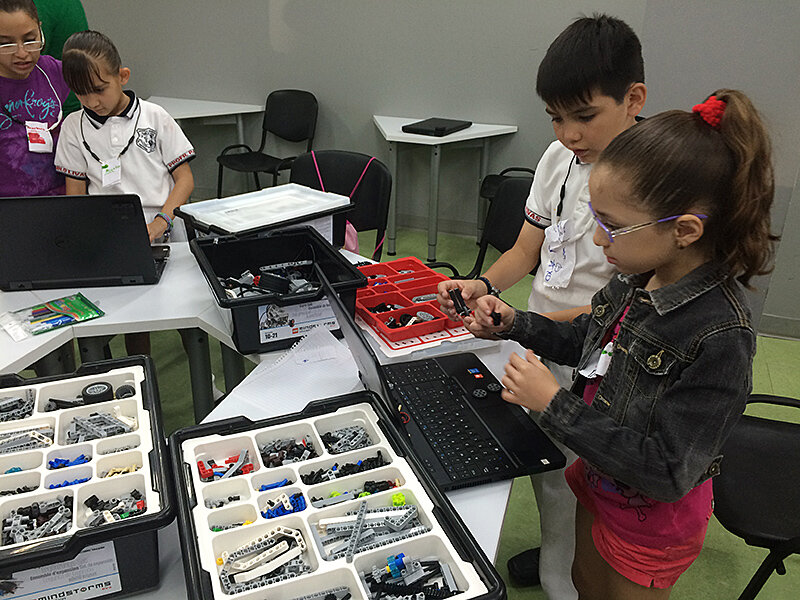In deserted strip mall, Mexico moves to seed a high-tech future
Loading...
| Monterrey, Mexico
An 11-year-old girl with a slicked-back ponytail stands at the head of a classroom here and grins as she displays a small prototype of her latest revolutionary idea: a four-wheeled contraption with a giant tube that can swivel 360 degrees. Its purpose? To drive through her neighborhood’s streets and vacuum up trash and litter.
Modern tales of invention and entrepreneurship often start in the family garage. But here in Mexico, it might just be a brightly lit classroom tucked into a deserted strip mall that produces the next generation of innovators.
This is robotics 101 – launched in February through Mexico Conectado, a government-funded network of digitally-connected community centers that focus on new technology. The free courses for kids between the ages of 8 and 13 mix design, scientific theory, and execution in at least one city in every state and the federal district. So far, 2,623 kids have participated in a beginner or intermediate course, and anyone can sign up.
For Mexico, it’s a new step – and potential model – in trying to address glaring barriers to increasing the nation’s international competitiveness, particularly in sectors like aerospace and information technology. Some 40 percent of students drop out before completing high school, and about two-thirds of the population doesn’t have access to the Internet, creating a gaping digital divide. Even among the kids in this course, about half don’t have computers at home, according to program staff.
Beyond the bid to develop technological savvy, classes like this may have other unintended positive effects that could change Mexico’s competitive landscape.
“Digital literacy is a foundational skill, like mathematics,” says Fernando M. Reimers, a Harvard University professor of education who focuses on innovation.
“But beyond knowledge of a discipline, you need to know how to apply that knowledge in order to solve problems,” Mr. Reimers says – something the robotics classes appear to do by having the kids pinpoint a problem in their communities and dream up solutions.
A growing disconnect
If such efforts gain traction, they could boost an education system that is struggling to stay relevant. A landmark education reform, passed in 2013, promises to invest more resources into the nation’s neediest schools and create a more merit-based system for the hiring and promotion of teachers. But many consider it primarily a labor reform, and it has hit a number of roadblocks, most recently the brief suspension of teacher evaluations, a cornerstone of the effort.
The robotics courses, however, include many elements Mexico has so far been unable to deliver on in its public education system: small class sizes with lots of personal attention, an emphasis on teamwork, the application of theories through hands-on projects, and encouragement of independent thought and creation.
As is the case in many Latin American countries, there’s a growing gap between the skills students graduate with and the skills employers are looking for, says Giulia Salieri, who has managed education research at the Mexican think tank Fundación IDEA.
In a study conducted about four years ago, Ms. Salieri and her team found that employers complained there weren’t enough engineers here. But at the same time, many Mexicans graduating with engineering degrees were ending up in completely unrelated careers after failing to land a job in their field.
Salieri and her team found that “even if the engineers had the hard skills, they may have lacked necessary qualities like leadership, working with other people, or problem-solving,” which made them unappealing to recruiters.
'Learn by playing'
Back in the community center classroom, the kids are broken up into two groups, with the boys and girls wearing name tags that read things like “battery,” “push button,” and “resistance.”
As they organize their bodies into lines and zig-zagging formations, trying to build a human circuit, an eight-year-old girl directs her peers using big arm motions while jumping up and down. Another student quietly throws his hands over his mouth as if transfixed by a great idea, before whispering quietly to his team.
Instructor Carlos Alberto Guzmán Lucio bobs between groups, asking questions and subtly correcting “broken circuits.”
“A lot of people might think, ‘physics, how boring,’ ” says Mr. Guzmán. “But here, the kids learn by playing.” The classes run for three hours, and there isn’t a moment this afternoon that the students seem distracted.
At one point Guzmán quizzes his class on Newton’s law; the next, they’re holding “frog races” where they bounce makeshift robots with rubber-band joints down a line of tape.
“I didn’t have opportunities like this,” says Guzmán. “They’re learning themes I didn’t touch until I was in college."
This weekend, about 1,400 kids around the country will converge on their local Mexico Conectado community centers to compete in a robotics competition. Semi-finals are at the end of the month, and the top 40 kids nationwide will be sent on a weeklong trip to Silicon Valley.
Barbara, the young girl who dreamed up the robotic street-cleaner, says she’ll compete if mom lets her. “My favorite part is the construction. Thinking up new ideas,” she says.
“It doesn’t have to be robotics,” says Reimers. “But the school day is too short and often too regimented…. Any opportunity to learn outside of school, outside the box; it can change a child’s course.”








